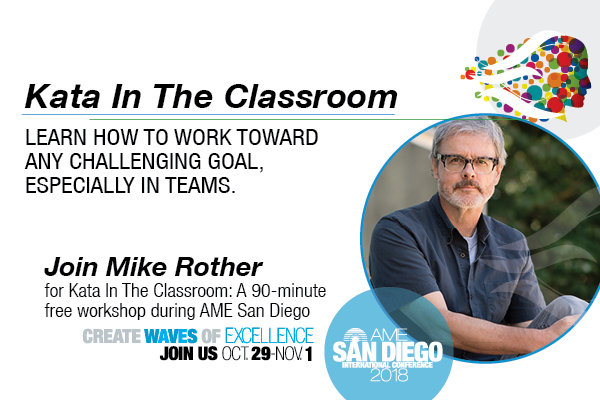By Mike Rother and Mark Rosenthal
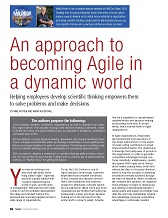 This article was originally published in AME's Target magazine, Vol 34, No. 2, Summer Issue 2018
This article was originally published in AME's Target magazine, Vol 34, No. 2, Summer Issue 2018
Helping employees develop scientific thinking empowers them to solve problems and make decisions
The authors propose the following:
(1) In complex, dynamic conditions, organizations do well to operate in an adaptive, Agile manner. This requires moving some decision-making downward, closer to where the action and quick feedback are, as opposed to traditional, centralized command-and-control.
(2) Successfully moving decision-making downward may require teaching teams how to navigate unpredictable paths by thinking scientifically, to avoid getting misled by our human tendency to jump to conclusions. Practicing and coaching some form of scientific thinking may be a prerequisite for successful empowerment.
(3) If you want to develop a shared set of scientific-thinking skills in teams of people, it’s a good idea for each learner to begin with a common set of starter practice routines, or “Starter Kata,” for getting the basics.
You may be noticing more and more talk about something called “Agile.” Agile has become a global subject that could be transforming the world of work, and the work of management. Although the term Agile comes to us from software development, the ideas and mindset behind this approach are now being applied across a wide range of organizations.
So far, the 21st Century is one of rapid change in technology, customer expectations and market conditions. In this complex and dynamic environment, the maneuvers and solutions required to effectively compete cannot be pre-planned in detail. More and more organizations are finding that traditional, bureaucratic, linear, top-down decision making is too far removed from the action and too slow to adapt. Adaptation via a capability for decentralized creative efforts and decision-making is becoming more vital. In broad terms, that’s how we think of Agile organizations.
In Agile organizations, employees are transformed from executors of top-down instructions to more autonomously acting contributors in small interconnected teams. The objective is to leverage the brainpower of people in the organization, in order to generate competitive advantage through customer sensitivity, adaptiveness, quality and speed. With Agile, we’re talking about teams making many small innovations per day, in a focused direction, which is how the process of achieving innovation normally functions (though we may not realize it). When conditions are complex and dynamic, an organizational strategy focused on developing and utilizing a decentralized ability to sense reality and adjust accordingly may offer the only truly sustainable competitive advantage, because competitive advantage is continually created.

Scientific thinking is a way to find your way. You make a prediction or have an expectation, reality happens, and if there’s a difference you learn and adjust. Source: "Toyota Kata Practice Guide.”
Empowerment lessons from the past
We view Agile as a form of empowerment. For example, Agile organizations often re-mix ad-hoc teams in what resemble temporary entrepreneurial ventures. However, as in many past efforts, some organizations are more successful than others in making these kinds of shifts. The empowerment idea is not new, but so far it has not worked to a significant degree in the business world.
One obstacle has been the unanswered question of How do we ensure that our teams are working on the right things in an effective way? This leads many companies back to using top-down bureaucracy, which is the habit they are more familiar and comfortable with. For example, in the 1990’s the business world tried a largely hands-off version of empowerment by renaming teams “self-directed work teams.” Businesses soon retreated from this when it became apparent that such teams tend to focus on what they do and don’t want to do, rather than on the customer’s needs, and often get paralyzed in debate. Something was still missing from the mix.
Failures of these various empowerment efforts are interesting because, if you analyze them, they can provide some insights that help us see further. From our observations, we think that one of the biggest errors in empowering teams has been an assumption that groups of people will naturally become effective teams on their own. Giving teams autonomy is an attractive idea, but it doesn’t automatically mean they will make good decisions.
We notice that organizations that have been successful with empowerment, like Toyota and Menlo Innovations (more about Menlo in a moment), go a step further by also creating structure and formal processes that teach their people how to work. We believe one of the missing ingredients in empowerment has been support or coaching by managers in a scientific way of thinking, which helps team members learn how to counteract their natural cognitive biases and navigate effectively in volatile, uncertain, complex and ambiguous conditions.
Agile = A practical application of scientific thinking
An underlying element in successful Agile practice is a form of scientific thinking. Ever notice the following?
- There’s no data about the future.
- Possibilities beyond what we currently know can’t yet be seen.
- Any plan gets out of sync when conditions change.
Since no one knows what the world will look like in the future, even the near future, Agile organizations use the ability to learn and adapt. Scientific thinking is exactly that: a process of deliberately engaging reality with the intent of learning.
You can think of scientific thinking as a continuous comparison between what we predict will happen next, seeing what actually happens and adjusting our next actions based on what we learn from the difference. Teams and organizations can use scientific thinking to help them set and achieve goals even though the path can’t be fully known ahead of time. You iterate your way forward—always adding to knowledge as you take steps— instead of trying to completely decide your way forward ahead of time. Any organization can use scientific thinking to bring forth and use our remarkable but latent human creative capabilities, and routinely achieve astonishing things.
What goals and problems will your teams face in the future? No one knows for sure. Scientific thinking is a kind of universal “meta skill”—meaning that it’s useful for developing solutions in any situation—and it may be the most effective means we currently have for navigating through unpredictable and complex territory toward challenging goals. Meta skills tell us how to proceed, but not the content of solutions, and can thus be applied to an infinite variety of situations.
Scientific thinking: an oasis of stability
Practicing scientific thinking creates a kind of island of stability, because it provides a consistent way of working in the midst of complexity and change. All of us need something to hold on to and steady us when we step into the unknown. One option is to hold on to preconceived notions of how things will go. But the future isn’t that predictable. When we practice a scientific way of proceeding we can shift from relying on preconceptions to relying on a means for navigating, and thereby become more open and able to tap our creativity. You still make a plan, of course, but now you can view that plan as a prediction.
Practicing scientific thinking doesn’t reduce uncertainty, it makes you more comfortable in uncertainty because you’ve mastered a way of dealing with it. You become more resilient, less afraid of making mistakes and more comfortable in your learning zone.
Successful empowerment needs people skilled in scientific thinking
What we are proposing is that developing a scientific way of thinking among the members of a team may be a prerequisite for effectively increasing their empowerment and leading to a more Agile organization. These are skills that prepare teams for more independent but strategically-aligned decisionmaking, and prepare managers to function more as coaches.
Scientific thinking is not difficult. The barrier is that it does not come naturally to us. The default way we think about problems and goals involves the unconscious part of our brain taking bits of surface information, quickly jumping to conclusions and giving us a false sense of confidence. We feel certain, and that’s when we start making mistakes.
Because a scientific way of thinking is not usually our default mode, it cannot simply be directed, it must be learned. One way of doing this, which Mike observed at Toyota, is to have people practice practical routines of scientific thinking while they do their normal work. The workplace is the classroom, and managers are the coaches. With Agile, managers shift from telling employees what to do, to coaching them in their day-to-day work. This requires investing in sharpening managers’ coaching skills. Of course, those managers are first going to have to be learners themselves.
Toyota Kata: Helping you modify your thinking
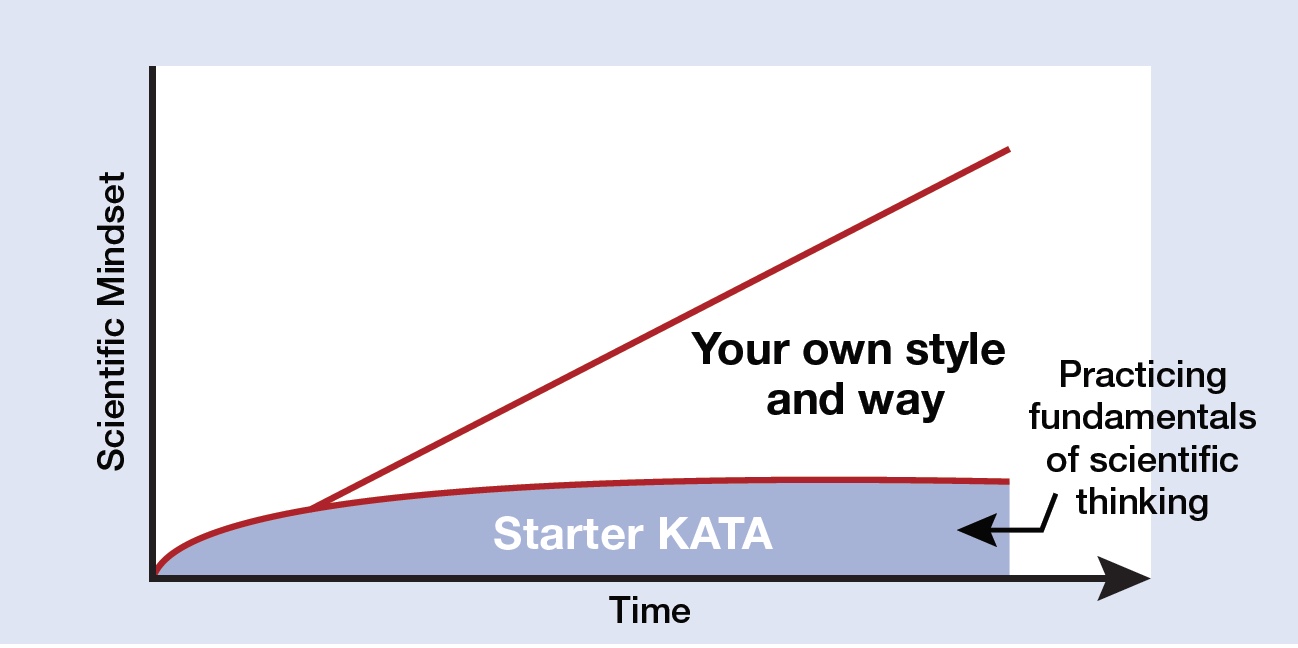
The Toyota Kata Starter Kata help you develop skills in scientific-thinking fundamentals, which you build on.
A key strength of Toyota is that its management process develops scientific- thinking skill and mindset in its people. At this point you have probably heard of “Toyota Kata.” Based on Mike’s research on Toyota’s management system, Toyota Kata is a way of developing scientific-thinking skill and mindset in any team or organization, through practicing something called “Starter Kata.” Toyota Kata doesn’t teach problem solving, but rather a scientific mindset that makes us more effective at problem solving.
Starter Kata are small routines or protocols that get practiced deliberately, especially at the beginning, to help you acquire skill fundamentals. It’s like playing scales in music. The goal is not the Starter Kata themselves, which get used less as you grow more proficient, but the habits of thinking and acting that practicing them leaves behind, and which you can then build on. They’re stepping stones to new ways of thinking and acting.
There are two main elements within Toyota Kata. One is the remarkably effective four-step Improvement Kata pattern, which helps develop fundamental skills of working like a scientist. The other is the Coaching Kata, which is about practicing the learner-coach relationship for teaching the Improvement Kata pattern. The Improvement Kata and Coaching Kata each have their own set of Starter Kata. Those Starter Kata increase the speed and scalability of learning, and are particularly helpful when you want to develop a shared scientific mindset in a group of people, because everyone starts with practicing the same basics. Practicing the Toyota Kata Starter Kata helps you build capability for more effective decentralized decision-making. There’s lots of information about Toyota Kata online and in the “Toyota Kata” series of books from McGraw-Hill.
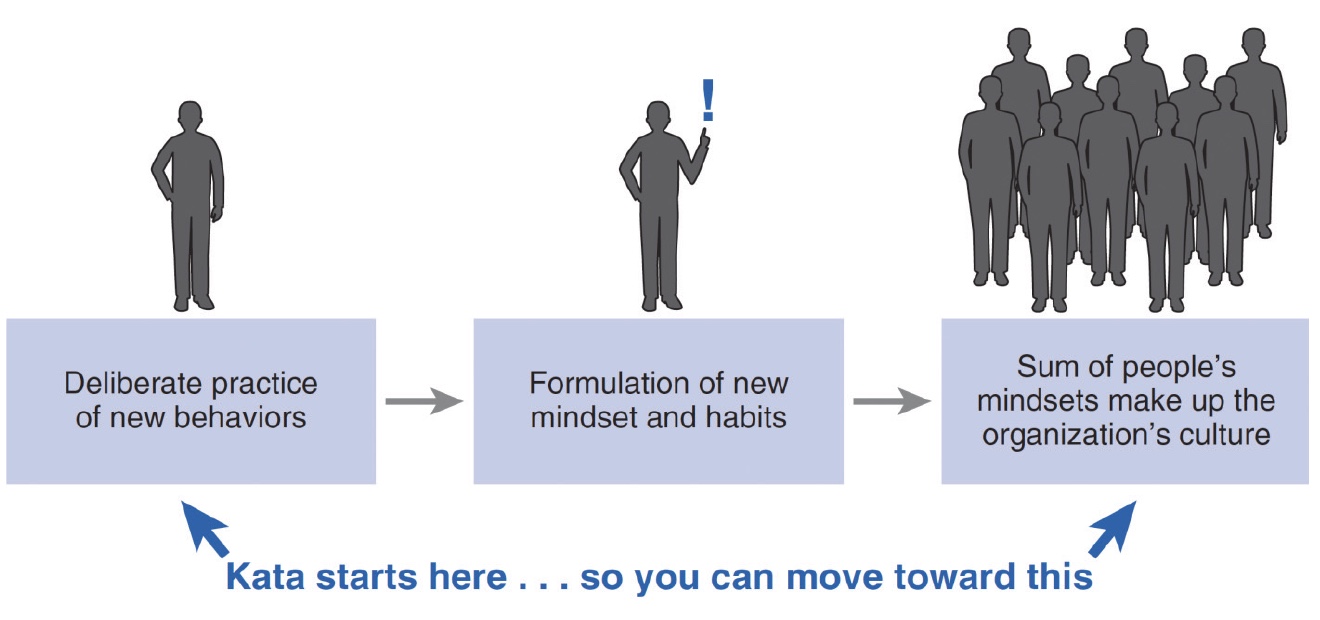
Individual practice builds capability for more decentralized decision-making and navigating. Source: “Toyota Kata Practice Guide.”
A new role for managers: Create the creators
Empowering teams to operate more independently may require helping them learn some scientific-thinking skills, which will enable them to make decisions more autonomously and maneuver situationally. Managers play a key role in this, because just about every learner needs a coach. It’s simple math: In nearly any organization, the only people who are physically available to meet with and coach every person every day are the managers and supervisors.
Professor Jeff Liker on practicing Starter Kata
I started playing guitar when I was 13. I played every day for at least an hour. When I went to visit a family member or on vacation, I always took my guitar along. But I didn’t take lessons. When I was 57, I started taking guitar lessons. The first thing the teacher asked me to do was to play a piece so he could watch and listen. Then he asked me to pluck a single string. I did that, plucking that string and thinking, big deal, I’ve been doing this for most of my life.
Then the teacher told me to try to pluck the string so that my fingernail and skin connect with the string at the same time. You can notice a difference in the sound. The guitar teacher told me to do that every day for 10 minutes playing a few simple patterns, until next week’s lesson. OK, I’ve been playing guitar for decades and now I’m just doing this plucking for 10 minutes a day.
In the next lesson the teacher asked me to play the same piece again, and I could immediately hear the difference from that one week of practicing that kind of “dumb” exercise. And that’s what started to connect me to practice of Kata—to the idea of practicing a basic skill element that you can then build on, and build on, and build on.
In learning new skills, you begin by practicing some Starter Kata until their patterns become routine, then you can begin to break away from the Kata, and then you can leave the Kata behind and focus on the “music” that you want to make. The professional musicians we admire have learned basic routines to the point that they are second nature, enabling them to focus on interpretation and creating new combinations of sounds.
It’s called “deliberate practice.” Just as in sports and music, when anyone begins learning a new skill, it’s not only best to practice a little every day, but also to receive corrective feedback from a coach so you practice the right moves. Without corrections from a coach, a beginner will naturally tend to practice their existing habits, rather than the still-awkward new way.
There are two problems. First, managers have to know and agree on what to coach. You cannot give corrective feedback unless you have an agreed upon model of what correct looks like. That’s the Improvement Kata’s scientificthinking pattern. Second, people in managerial positions often don’t have experience in coaching others in a scientific-thinking, so they need to be trained to be coaches. That’s what the Coaching Kata and its associated Starter Kata practice routines are for.
The main Starter Kata for a coach is the five Coaching Kata questions, which are the headings in “coaching cycles.” Coaching cycles are daily dialogues between the coach and a learner that take 20 minutes or less, and are the primary point of interaction between the coach and the learner. The purpose of a coaching cycle is to review the learner’s current application of scientific thinking, engage the learner and coach in thinking out loud about how the learner is working, and provide feedback as necessary regarding the learner’s next round of practice. Notice the difference: The coach focuses on the learner’s way of working, not the content. Practicing the Coaching Kata teaches you how to do that.
Using scientific thinking to develop a scientifically thinking organization
Anyone wanting to adopt the Agile approach should recognize that this is more than a project of implementing a set of Agile tools. You are modifying the dynamics of how an organization functions. The path you will end up taking in achieving this change isn’t completely predictable.
Fortunately, since scientific thinking is a universal meta skill that’s suitable for any goal, the same scientific-thinking approach works for deploying Agile mindset and habits in your own organization.
That’s what happened at Menlo Innovations in Ann Arbor, Michigan. Menlo is a well-known Agile benchmark, hosting thousands of visitors every year who seek to understand “The Menlo Way.”
Back at their beginning, Menlo’s founders Richard Sheridan and James Goebel didn’t simply decide one day to “be Agile.” They envisioned a deliberate culture that ended their previous experience of the “software death march,” with its low morale, long hours and failed projects. While they used Kent Beck’s book, “Extreme Programming Explained,” as a blueprint, they applied a scientific mindset to incrementally learn how to make the system work for them and their vision, in their setting.
Their first experiment was with two programmers who volunteered to try working as a pair for a few days. They practiced, learned, adjusted and, over time, created a now deeply-embedded structure and way of working that their teams believe in and practice every day.
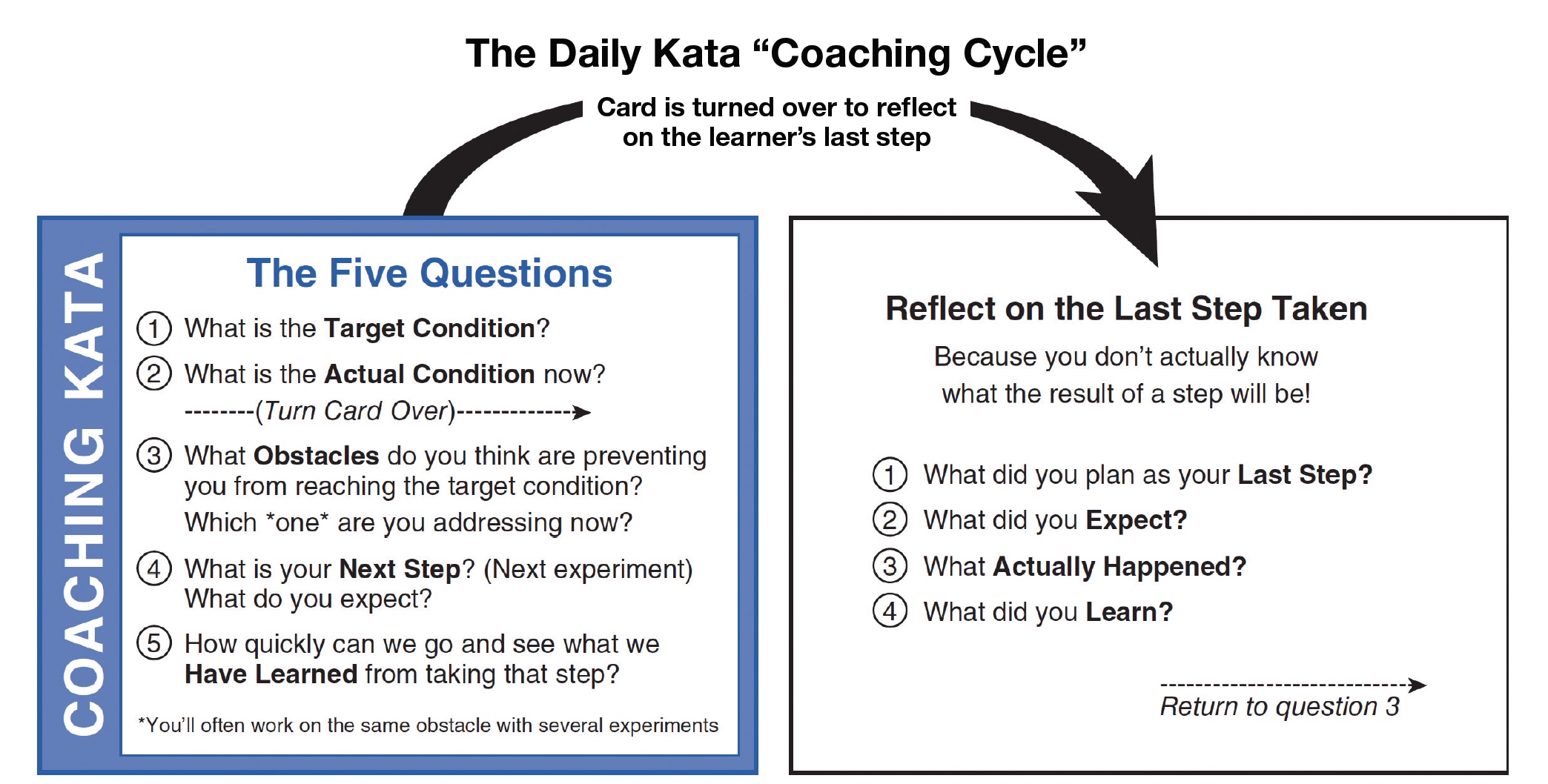
A daily Starter Kata for learning how to teach scientific thinking. Source: Toyota Kata Website.
Today Menlo doesn’t need a bureaucratic, top-down management system to check whether teams are staying on task and doing their jobs. Instead, leaders and managers at Menlo are responsible for how people work, not the content of their work and problem solving.
If you want to become more Agile in your organization, a few lessons from Menlo’s path are:
• Know where you want to go. Understand the shift that Agile is about.
• Start small, so you can iterate, learn and adjust more quickly. Nothing works as intended at first.
• Run deployment experiments with a scientific approach. Use the Toyota Kata if you like.
• You’re not testing to see if Agile works, but how to make Agile work in your business. Solve one problem at a time until it is working for you in your setting.
• Every organization is different. Scale up as you learn, not based on your preconceived notions about how you think deployment will go.
Agile = A way of managing for our time
The management methods of the 20th century were arguably intended to reduce uncertainty, whereas the management methods of the 21st century may be as much about being effective and comfortable working within unavoidable uncertainty. That’s Agile.
Agile is about managing ourselves in a different way, to make our remarkable human abilities come to the fore. To do that, one of the most important things for managers to focus on is the patterns of thinking and acting we utilize as we strive for goals. What we are talking about is making the development of the creative capability and confidence of people in the organization a main aspect, and possibly the main aspect, of a manager’s job.
It’s quite amazing what we can achieve through practicing a practical form of scientific thinking. We humans are well equipped to meet challenges of all sorts—if we practice an effective way of doing that. Debating is not the most effective way of tapping our brainpower and collaborating to meet challenging goals. Argue instead about what might be the best next experiment on the way to your goal. Then do that experiment as soon as you can and see further.
Although practicing new skills involves effort and some initial discomfort, the more scientific thinking capability you develop in your teams, the more you can empower them to meet challenges that may have once seemed impossible. Based on our experience, you will quickly come to enjoy Toyota Kata. You’re likely to find the practice will even change your life.
Mike Rother is an engineer, researcher and teacher who works to develop scientific thinking in individuals, teams and organizations. He shares his findings widely and is in the AME Hall of Fame.
Mark Rosenthal is a principal at Novayama LLC. Follow his blog at TheLeanThinker.com.


